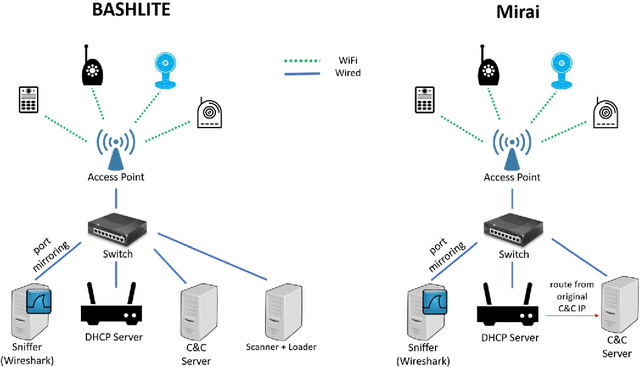Michael Bohadana
N-BaIoT: Network-based Detection of IoT Botnet Attacks Using Deep Autoencoders
May 09, 2018



Abstract:The proliferation of IoT devices which can be more easily compromised than desktop computers has led to an increase in the occurrence of IoT based botnet attacks. In order to mitigate this new threat there is a need to develop new methods for detecting attacks launched from compromised IoT devices and differentiate between hour and millisecond long IoTbased attacks. In this paper we propose and empirically evaluate a novel network based anomaly detection method which extracts behavior snapshots of the network and uses deep autoencoders to detect anomalous network traffic emanating from compromised IoT devices. To evaluate our method, we infected nine commercial IoT devices in our lab with two of the most widely known IoT based botnets, Mirai and BASHLITE. Our evaluation results demonstrated our proposed method's ability to accurately and instantly detect the attacks as they were being launched from the compromised IoT devices which were part of a botnet.
Detection of Unauthorized IoT Devices Using Machine Learning Techniques
Sep 14, 2017



Abstract:Security experts have demonstrated numerous risks imposed by Internet of Things (IoT) devices on organizations. Due to the widespread adoption of such devices, their diversity, standardization obstacles, and inherent mobility, organizations require an intelligent mechanism capable of automatically detecting suspicious IoT devices connected to their networks. In particular, devices not included in a white list of trustworthy IoT device types (allowed to be used within the organizational premises) should be detected. In this research, Random Forest, a supervised machine learning algorithm, was applied to features extracted from network traffic data with the aim of accurately identifying IoT device types from the white list. To train and evaluate multi-class classifiers, we collected and manually labeled network traffic data from 17 distinct IoT devices, representing nine types of IoT devices. Based on the classification of 20 consecutive sessions and the use of majority rule, IoT device types that are not on the white list were correctly detected as unknown in 96% of test cases (on average), and white listed device types were correctly classified by their actual types in 99% of cases. Some IoT device types were identified quicker than others (e.g., sockets and thermostats were successfully detected within five TCP sessions of connecting to the network). Perfect detection of unauthorized IoT device types was achieved upon analyzing 110 consecutive sessions; perfect classification of white listed types required 346 consecutive sessions, 110 of which resulted in 99.49% accuracy. Further experiments demonstrated the successful applicability of classifiers trained in one location and tested on another. In addition, a discussion is provided regarding the resilience of our machine learning-based IoT white listing method to adversarial attacks.
 Add to Chrome
Add to Chrome Add to Firefox
Add to Firefox Add to Edge
Add to Edge